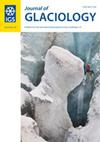南极洲西部Lago冰下CECs的水深和海床条件
IF 2.6
3区 地球科学
Q2 GEOGRAPHY, PHYSICAL
引用次数: 0
摘要
虽然利用雷达和卫星观测已经确定了600多个南极冰下湖泊,但对了解湖泊内部条件至关重要的水深和河床性质,只在极少数地方确定了。我们展示了位于南极洲Rutford-Institute-Minnesota分界处2653米冰下的Lago冰下cec (SLC)的水柱厚度和湖床特性的测量结果。地震剖面显示,湖最宽处水柱最大厚度为301.3±1.5 m,湖体积估计为2.5±0.3 km3。冰基和湖床的地震成像和反射强度测量表明,湖床中部有> ~ 15m的高孔隙度细粒沉积物,与沉积序列一致,沉积年龄可达0.5 Ma。这些观测结果,加上之前的雷达测量和建模,表明这是一个低能量的沉积环境,水停留时间很长。因此,通过直接获取冰盖沉积物记录和气候历史,以及研究长期隔离的微生物生活,SLC是一个合适的勘探目标。本文章由计算机程序翻译,如有差异,请以英文原文为准。
Bathymetry and bed conditions of Lago Subglacial CECs, West Antarctica
Although over 600 Antarctic subglacial lakes have been identified using radar and satellite observations, the bathymetry and bed properties, which are key to understanding conditions within the lake, have been determined in very few localities. We present measurements of water column thickness and lakebed properties from Lago Subglacial CECs (SLC), located beneath 2653 m of ice at the Rutford-Institute-Minnesota divide in Antarctica. Seismic profiles indicate a maximum water column thickness of 301.3 ± 1.5 m, at the widest part of the lake, with an estimated lake volume of 2.5 ± 0.3 km3. Seismic imaging and measurements of the reflection strength at the ice base and lakebed indicate >15 m of high-porosity fine-grained sediment in the central section of the lakebed, consistent with a depositional sequence with an age of up to 0.5 Ma. These observations, along with previous radar measurements and modelling, indicate a low-energy sedimentary environment with a long water-residence time. As such, SLC is a suitable target for exploration via direct access to recover sediment records of ice sheet and climate history and investigate microbial life with long periods of isolation.
求助全文
通过发布文献求助,成功后即可免费获取论文全文。
去求助
来源期刊

Journal of Glaciology
地学-地球科学综合
CiteScore
5.80
自引率
14.70%
发文量
101
审稿时长
6 months
期刊介绍:
Journal of Glaciology publishes original scientific articles and letters in any aspect of glaciology- the study of ice. Studies of natural, artificial, and extraterrestrial ice and snow, as well as interactions between ice, snow and the atmospheric, oceanic and subglacial environment are all eligible. They may be based on field work, remote sensing, laboratory investigations, theoretical analysis or numerical modelling, or may report on newly developed glaciological instruments. Subjects covered recently in the Journal have included palaeoclimatology and the chemistry of the atmosphere as revealed in ice cores; theoretical and applied physics and chemistry of ice; the dynamics of glaciers and ice sheets, and changes in their extent and mass under climatic forcing; glacier energy balances at all scales; glacial landforms, and glaciers as geomorphic agents; snow science in all its aspects; ice as a host for surface and subglacial ecosystems; sea ice, icebergs and lake ice; and avalanche dynamics and other glacial hazards to human activity. Studies of permafrost and of ice in the Earth’s atmosphere are also within the domain of the Journal, as are interdisciplinary applications to engineering, biological, and social sciences, and studies in the history of glaciology.
 求助内容:
求助内容: 应助结果提醒方式:
应助结果提醒方式:


